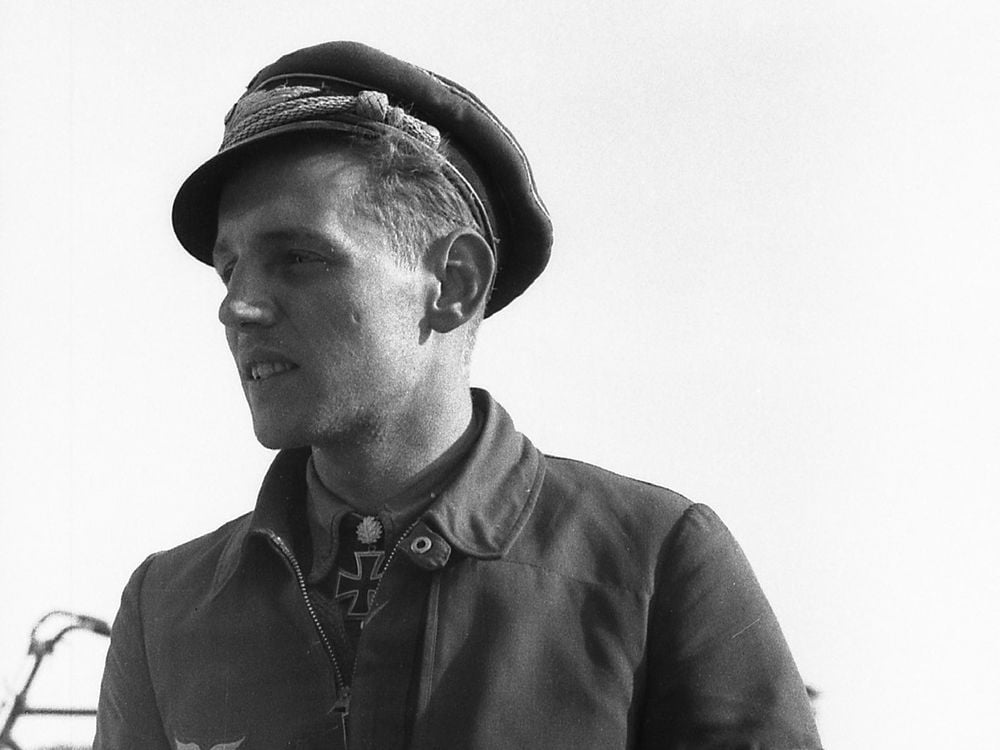
Ace of Aces
Erich Hartmann amassed a remarkable tally of 352 aerial victories during World War II.
By May 8, 1945, Adolf Hitler had been dead for more than a week. Germany was in the act of formally surrendering to the Soviets and the Western Allies, so occupying Red Army troops in the eastern German town of Brunn were not expecting to witness what may have been World War II’s last dogfight over Europe.
They were watching entranced as a Red Air Force pilot entertained them with a one-plane air show. He expertly put his Yakovlev Yak-9 single-engine fighter through a series of intricate rolls, climbs, dives, and stalls while the infantrymen below applauded. Suddenly, a lone German Messerschmitt Me-109 dove on the unsuspecting Russian, riddling his Yak with machine-gun bullets and 20mm cannon shells and sending it spinning toward the German countryside. As the stunned soldiers gathered around the oily bonfire that seconds earlier had been a lethal flying machine, the Luftwaffe pilot banked westward toward his final landing. Erich Hartmann, aerial warfare’s supreme ace, had just scored his last kill—number 352.
The son of a doctor, Hartmann was born on April 19, 1922. It was a hard time to be German. Just 31/2 years after its defeat in World War I, the Fatherland was helpless before its victorious, unsympathetic enemies. Political upheaval, poverty, and the worst inflation in history made life in Germany difficult, destitute, and dangerous. Jumping at the opportunity to escape this situation, Dr. Alfred Hartmann moved his practice to China. Despite the language barrier he got on well with his new patients, who were grateful to have such a skilled physician to tend their many maladies. They gathered at his office daily and gladly paid their bills on time. Being German, Dr. Hartmann was not generally associated with the European colonial powers that Asian nationalists were increasingly resisting. Nevertheless, when he found the severed heads of three British acquaintances on stakes outside his door one morning in 1929, he decided to gather up his beautiful wife Elisabeth and two little boys and return home, where he set up a new practice in Stuttgart.
During the 1930s, while their country underwent drastic changes, Elisabeth and her sons embraced the national craze of gliding. Her eldest, Erich, developed a passionate love of flying, becoming one of many young Germans addicted to the sky. By the time Hitler came to power in 1933, an entire generation of Germany’s young men were yearning to be aviators.
Erich Hartmann was born too late to participate in the Third Reich’s early period of conquest from 1939 until mid-1942. In fact, when the European war broke out in September 1939, he had just been conscripted, at age 17, into the Hitler Youth. Still, he was enthusiastic about the war. It would give him the opportunity to pursue his dream of flight, so as soon as he graduated from high school in the spring of 1940, he enlisted in the Military Training Regiment based at Neukuhren, East Prussia. A free spirit, he would never completely conform to the restrictions of Nazi German military life. Also, he was emotionally distracted. He was madly in love with 16-year-old Ursula Paetsch, and the two were planning to marry as soon as possible.
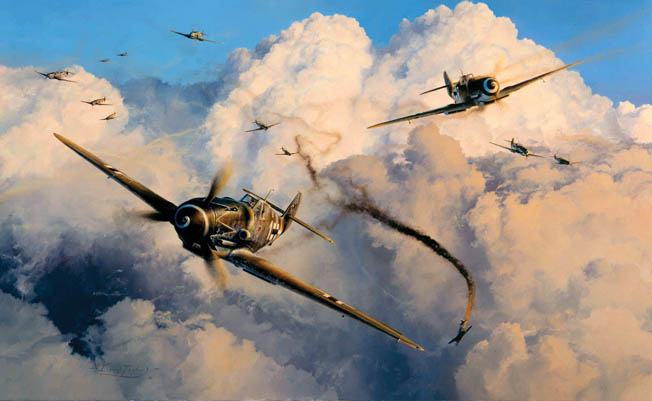
Hartmann’s fun-loving inclinations and determination to stay closely in touch with his fianceé frustrated his regulation-bound flight instructors, but his flying ability became apparent as he quickly mastered the deadly but notoriously difficult to fly Me-109D. Unwilling to wash out such a terribly gifted student, the instructors tolerated his lack of self-discipline as he continued to impress them in training.
As the pivotal summer of 1942 broke over war-torn Europe, Hartmann approached his final stages of training with typical brilliance, scoring 24 hits on a small, fluttering, infamously hard to hit drogue target towed by another plane on June 30. This was by far the best his instructors had ever seen from a trainee in his first attempt at aerial gunnery. One of Hartmann’s future comrades on the Russian Front, Wilhelm Batz, literally took years to achieve such marksmanship. Considering Batz would finish the war with 237 kills, Hartmann’s ability was apparent.
After graduating from flight training, Erich was allowed a short visit to Stuttgart to see his parents and Ursula. Then, his superiors, anxious to get this deadly young hawk into action, rushed him to the Russian city of Maikop, where he joined Jagdgeschwader (Fighter Wing) 52, or JG-52. He would spend the rest of the war in the East, but first he had to overcome a shaky start.
En route to their posting, he and three other novice second lieutenants passed through Krakow, Poland. There were no Me-109s stationed at the local Luftwaffe airfield, but the base commander had four Junkers Ju-87 Stuka dive bombers he needed delivered to Mariupol on the north coast of the Sea of Azov. He told the rookies that if they flew the Stukas to their destination they would have no trouble arranging transportation to nearby Maikop.
Although utterly unfamiliar with the Ju-87, the first two lieutenants managed to lift off safely, but Hartmann and his last companion were another story. As Hartmann taxied down the dirt runway, his plane’s brakes failed, and he crashed into the air traffic controller’s wooden hut at the end of the landing strip, destroying both shed and plane. When the last youngster attempted to get airborne, his engine caught fire. When he tried to make an emergency landing, he somersaulted his Stuka.
The commander, knowing he would be held responsible for the destruction, rushed the two “baby pilots” into the cargo bay of an eastbound Junkers Ju-52 transport plane before they could inflict more havoc. Hartmann’s introduction to the convulsing Russian Front was as chaotic as the massive battles raging along its endless length that autumn of 1942.
JG-52 was already established as a top Luftwaffe unit upon Hartmann’s arrival. His commanding officer, 27-year-old Colonel Dietrich Hrabak, was immediately impressed with the fearless confidence of this new arrival. Considering Hrabak already had 60 kills and wore the Knight’s Cross, his opinion carried weight. He instantly had a high estimation of Hartmann. Hrabak immediately commenced versing the newcomers on all the aspects of combat flying not covered in the flight schools—fine points that could only be gleaned and honed in battle.
“Up to now all your training has emphasized controlling your aircraft on operations, that is, making your muscles obey your will in flying your aircraft,” Hrabak said. “To survive in Russia and be successful fighter pilots you must now develop your thinking. You must act aggressively always, of course, or you will not be successful, but the aggressive spirit must be tempered with cunning, judgment, and intelligent thinking. Fly with your head and not with your muscles.”
Hrabak’s instructions to just arrived neophytes were always a great asset to them, saving many of their lives. Also, the free-spirited Hartmann liked the informality of the airmen at the front. Germany had been at war for three years by this point, and the tide was about to start turning. Never before had the Third Reich needed such young men as Erich Hartmann. Unfortunately for the Fatherland, there were far too few of his caliber.
On October 10, 1942, Hartmann was assigned to the wing’s III Gruppe, III/JG.52, which was based on the banks of the Terek River north of the Caucasus Mountains. Posted to 7th Staffel, the 20-year-old neophyte reported to the squad’s commander, Major Hubertus von Bonin, who was much in Hrabak’s mold, believing flying skill was more valuable than military modus operandi. Bonin informed the surprised recruit that rank did not determine which pilot commanded during combat operations. Whoever held the highest kill tally was in command while the units were airborne. A higher scoring lieutenant could chew out his commanding colonel in the heat of aerial battle, and not one word would be said about it after the planes landed. This state of affairs was perfect for Hartmann.
His first dawn patrol was October 14, and it was almost his last. He flew as wingman for Sergeant Edmund Rossmann, who had 80 kills at that time. Rossmann could teach as well as he could fight and usually managed to bring his rookie wingmen home. He had barely enough skill to save this one, though.
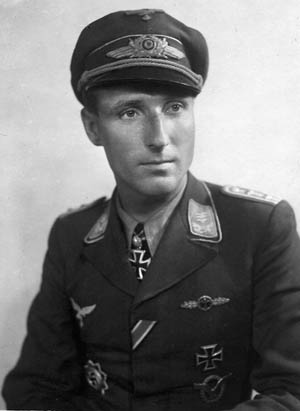
Major Wilhelm Batz tallied 237 victories with JG 52.
After climbing to 12,000 feet, the two-plane element followed the Terek River to the city of Prokhladny, where Rossmann spied a formation of Soviet aircraft strafing a German supply column that was trying to leave the city. Radioing for his green wingman to follow, Rossmann dove at the Russians while a confused Hartmann (who still had not spotted the targets) followed close behind. After a plunge of almost a mile, he finally picked out the Red Air Force flight that Rossmann had been zeroing in on all along.
Instantly livid with excitement, Hartmann overreacted and rammed his plane’s throttle up to full speed, rashly cut in front of Rossmann, and drew a bead on the closest Russian, pressing his fire button at 300 yards. Cleanly missing his target high and to the left, he found himself closing too fast to correct his aim. Pulling up at the last instant, he barely avoided a collision and managed to level off, but found himself “surrounded on all sides by dark green aircraft—all of them turning behind me for the kill … ME!”
Choking on fear, he pulled up into a cloud, where he was thankful to hear Rossmann’s calm, matter-of-fact voice over the radio telling him, “Don’t sweat it. I watched your tail. I’ve lost you now that you’ve climbed through the clouds. Come down through the layer so I can pick you up again.”
Easing lower until he was just beneath the overcast, the first thing Hartmann saw was a single-engine fighter coming straight at him. Thinking it was another Russian, he threw his Me-109 into a steep dive while yelling into his microphone that he was being chased. Leveling off just over the treetops he listened for a response, but by then Rossmann’s voice over the radio was too garbled for him to understand. Terrified, he churned full speed to the west until he lost his pursuer.
After outrunning the other plane, he continued to hurtle toward friendly airspace until his engine suddenly sputtered into fuel-starved silence. At such low altitude he did not have time to lower his landing gear. A full 20 miles short of his airfield, he belly landed in a choking cloud of dust. A squad of German infantrymen was passing by in an armored car. Amused at how shaken he was, they gave him a lift back to Soldatskaya. By the time he got there, Rossmann had landed and informed the colonel of Hartmann’s actions on the patrol. Bonin was waiting when the armored car arrived.
The “enemy” aircraft Hartmann had fled from in terror after dropping from the clouds had been Rossmann’s, and this was just one of seven major flying misdemeanors Hartmann had committed on this single flight. He had detached from his element leader without authorization, flown into Rossmann’s line of fire, gotten lost in the clouds, disobeyed Rossmann’s order to rejoin him, gotten lost while returning, and destroyed a valuable plane without inflicting any damage on the enemy. As von Bonin’s voice grew hoarse from shouting, he banished the unhappy amateur to three days of toiling with the ground crews. At the end of his sentence, Hartmann had grease-caked hands and a new regard for discipline in combat.
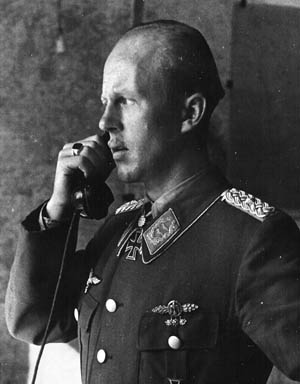
After getting back into the air, Hartmann resumed flying with Rossmann and studied the veteran’s fighting philosophy. Early in the war Rossmann had suffered a severe arm wound and was thus unable to yank his plane through the tight gyrations required for close-in dogfighting. His incredible eyesight saved his career, making it possible for him to pick out targets at extreme distances, diagnose each situation according to its unique characteristics, and then plot how he would carry out his personal unorthodox specialty of long-range surprise attack. His victims seldom saw him, exploding in flames before he was close enough for them to realize he was targeting them. He used these sniper’s tactics to bag Russians with monotonous regularity while his brother pilots charged bull-like into Soviet flights, downing victims in erratic bunches while taking almost as much abuse as they dished out. They would then coax their smoking machines back to base, barely making it there if at all. Rossmann, unscathed, would be waiting in the canteen.
Hartmann commenced copying Rossmann’s style of approaching aerial battlefields in a patient, methodical fashion, but unlike his mentor Hartmann had no lame arm and was able to whip his Me-109 through tight turns, climbs, and dives. With his own phenomenal marksmanship he was able to meld Rossmann’s rare ability to mortally wound victims at long range with the other pilots’ favored tactic of point-blank gunnery. Erich Hartmann received his first taste of blood on November 5, 1942.
He was part of a four-plane formation called a schwarm that took off at noon to oppose Red Air Force attacks on Wehrmacht armored and supply columns outside the city of Digors. Hartmann was first to spot the enemy formations and was shaken by their numerical superiority. He counted 18 Ilyushin Il-2 Shturmovik ground attack aircraft escorted by 10 Lavochkin Lagg-3 fighters. Hartmann’s little formation was commanded by a 1st Lt. Treppe, who ordered him to lead the charge.
With Treppe following closely, he took advantage of his optimal position above and behind the enemy. Diving through the surprised escorts before they could react, he pulled up and opened fire on the Shturmovik at the formation’s extreme left. He was dismayed as his machine-gun bullets and 20mm cannon shells bounced harmlessly off his target, which the Germans ruefully called the “Flying Tank.” One of JG-52’s veterans, however, had informed Hartmann that the Shturmovik had a vulnerable underside.
Simultaneously banking and diving, he almost hit the ground before pulling up, closing to just 200 feet, and opening fire on the Russian’s thinly protected oil cooler. As thick black smoke gushed from his underbelly, the Shturmovik pilot dropped from formation and headed eastward in a shallow dive in hopes of finding a clear area to belly land. Hartmann was right behind him.
As the thrilled young German drew a bead to finish off his first kill, the Il-2 suddenly blew up in a hail of debris. One of the twisted fragments plunged into the Me-109’s engine cowling, and flames now erupted from his own plane. He crash landed and climbed from his aircraft’s wreckage just in time to see his maiden kill hit the ground in a cloud of smoke, flames, and dust a mile to the east. Again he hitched a ride with a squad of infantrymen. He regaled them with the narrative of his first aerial victory, completely forgetting that although he had now downed a Russian machine he had also destroyed two German airplanes. Even so, he would barely survive an illness.
Hartmann contracted a fever that almost killed him. He spent the next month in the military hospital at Piatigorsk-Essentuki, being discharged the second week in December just as the Red Army closed its massive jaws around the hapless German 6th Army in Stalingrad. Germany’s “Blond Knight” would have no shortage of opportunities to whet his swiftly developing talents as the cold, cloudy Russian heavens filled with Soviet aircraft. Hartmann and his comrades spent few daylight minutes on the ground except to have their toiling Me-109s rearmed, refueled, and briefly serviced.
As he developed his fighting style Hartmann was able to get closer and closer to his targets before opening fire, fatally damaging them, and then sheering aside to safety at the last instant. He came to further appreciate this whites-of-the-eyes approach after he began flying as wingman for 1st Lt. Walter Krupinski, who carried the point-blank method to its extreme. Flying with total abandon and without bothering to maneuver, Krupinski would hurtle like a charging bull into Russian formations and spray ordnance into every target he could get in his sights. His marksmanship was marginal, but he fired so many rounds that numerous targets were inevitably hit in each shootout. By war’s end he had 197 kills.
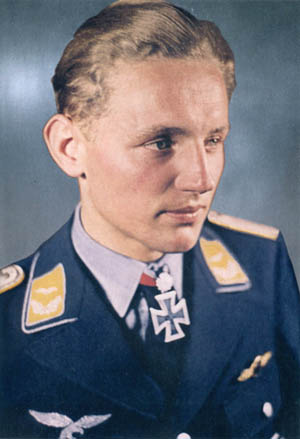
By following Krupinski, Hartmann had more targets of opportunity than were normal for a wingman, who typically was tasked with protecting his element leader’s tail. This trigger-happy lieutenant missed or barely nicked so many aircraft that his wingman was constantly, as he described it, “filling in the holes Kruppi left.”
Krupinski encouraged Hartmann to continue practicing his ambushing skills, but the youngster kept unconsciously emulating his idol Rossmann by opening fire from too great a range. Krupinski was constantly yelling over his radio, “Hey Bubi! Get in closer! You’re opening fire too far out!”
“Bubi” means “lad” in German, and it was perfect for the young airman. Before long the entire fighter group picked up on it. The Russians, however, would soon hang other monikers on him.
By the end of April 1943, Hartmann had completed his 100th combat mission and had eight kills. He was promoted to element leader but was still absorbing the methods of the other senior pilots in his group, combining them into a single, unique fighting style that would make him a legend.
By May 25, his tally had risen to 14, but that morning he had a near death experience when he collided with a LaGG-3 fighter and had to glide back to his own lines for a crash landing. He had been at the front for six months now, and the honeymoon was over. Still weak from the near-fatal fever, his nerves were starting to fray from the strain of constantly flying into massive swarms of Soviet warplanes. Also, the front had reversed direction—moving west instead of east. The realization that his side was going to lose did little for his morale. Hrabak sent him back to Stuttgart for a month-long reunion with his parents and Ursula, but rather than rejuvenate the young pilot the leave would have the opposite effect.
Hartmann returned to a Germany that was being scorched by mile-wide shoals of four-engine bombers of Britain’s Royal Air Force and the United States Army Air Forces. For the first time in history it was possible to completely destroy cities from the air, and while the threat to his loved ones disheartened him mightily it also infused him with a burning determination to do everything in his power to cut into the inexorable advance of his country’s enemies. Maybe his family could not fight the aerial menace, but he certainly could.
When he returned to JG-52, his comrades could see the change in him. He was no longer the happy-go-lucky, bubbly Bubi who was everybody’s precocious little brother. He was a silent, grim young warrior who could hardly wait to get into the air and destroy the enemy. Marshal Josef Stalin’s air legions were now facing their greatest one-man nemesis.
On July 5, Hartmann knocked down four Lavochkin La-5 fighters. He added four more two days later. Krupinski no longer had to tell him to close to within kissing distance before opening fire. Only when Hartmann’s targets filled his sights did he press his fire button, smothering his marks in hits and sending them down in flames.
He had fully overcome his amateur’s impetuousness and was possessed by the skill every wily veteran needs to successfully prey on his enemy. Late on the afternoon of August 3, he shot down another La-5, bringing his total to 50 aerial victories. Earlier in the war many German pilots had earned the Knight’s Cross for this achievement, but by this point the tottering Reich’s requirements had risen. Still, he would be recognized for his heroism.
At this point Hartmann was given command of the Group’s 9th Staffel (9/JG.52). He was almost constantly airborne during daylight hours, tearing gaps into the huge formations supporting the Red Army’s first major summer offensive. His whole wing was flying four sorties daily and downing Soviet machines in bunches. Still, the red star-emblazoned airplanes droned endlessly from the east. These were the biggest air battles in history, and they just kept growing with the arrival of another autumn.
Hartmann finally earned his Knight’s Cross by downing his 150th plane during a patrol on October 29. The two-week leave he received thrilled him more than his medal. Out of respect for his accomplishment, no one flew his finely tuned Me-109G while he was gone. The machine was emblazoned with a bleeding heart pierced by an arrow and the word “Uschi,” Ursula’s nickname. While in the air he used the call sign “Karaya One” (Sweetheart One), and by now the enemy knew this sobriquet as well as did his own side. The Russians even recognized his voice, and when they heard it or his call sign over the airwaves they would prudently give him a wide berth. They would not deprive him of targets for long, though. He had had another incredible adventure.
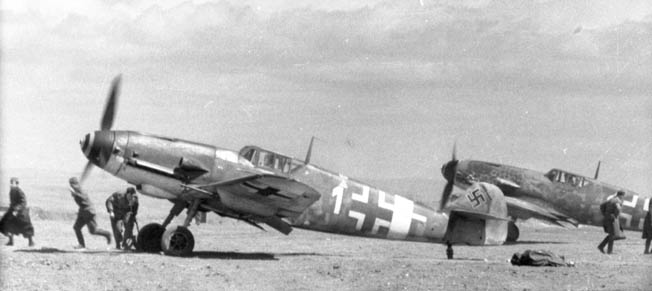
Late in August antiaircraft fire downed him over Russian lines. Belly landing in a field of sunflowers, he was quickly surrounded by Soviet infantrymen. He did such a masterful acting job of feigning serious internal injuries that he not only fooled the infantrymen, but also a Red Army doctor the soldiers delivered him to in a nearby village. Pretending to be comatose, he lay still as death as he was loaded onto a captured German truck and sent eastward, presumably to one of the notorious Soviet POW gulags.
When his guards were distracted by a formation of Stukas passing overhead, Hartmann leaped from the vehicle and pelted westward amid a barrage of small-arms fire, losing his pursuers in a field of six-foot-tall sunflowers. When he spied an enemy patrol that night, he followed it to the front and under cover of darkness made it to German lines. He was not out of danger yet.
A trigger-happy, teenaged German sentry shot at Hartmann, putting a Mauser bullet through his pants leg. The boy was so nervous because a few days earlier German-speaking Russians had ambushed his unit. There was no way he could get back to his outfit that night, so the German infantrymen he had come upon handed him a rifle. He helped them wipe out a patrol of drunken Russians that had strayed into German territory.
Hartmann’s odyssey left his nerves in shreds, but it was another month before his superiors could spare him a rest. Autumn rains finally slowed the inexorable Soviet onslaught, and he was able to go on leave. German pilots on the Russian Front in 1943 were possibly the busiest men in history.
With an eye for aesthetics, Hartmann had had his plane decorated with an unusual and distinctive black tulip petal design on its nose cone. By year’s end the Soviets had not only figured out the menace of the call sign Karaya One but could recognize his uniquely adorned aircraft. They were calling him the “Black Devil of the South” and placed a bounty of 10,000 rubles on his 21-year-old blond head. No one seemed interested in claiming the reward, however, as whenever his plane was recognized Red airmen would avoid him like a leper. He tried to trick the enemy by having his wingman fly the black-nosed Me-109, but the Russians steered so clear of it that they were also too far from Hartmann’s borrowed plane for him to attack them. In January 1944, he had the artwork removed. No longer so recognizable, he quickly shot down another 50 warplanes in January and February despite being grounded by bad weather much of that time.
JG-52 tore through its hapless enemies early in 1944. By this time the group’s pilots were so battle tested that their aircraft were essentially extensions of the nervous systems of the young men flying them. Mechanically honed to operative perfection by expert ground crews, the machines reacted instantly and perfectly to the slightest touch at their controls. The cold Russian skies were filled with the smoke trails of crashing Soviet aircraft, yet sheer weight of numbers would be a major deciding factor. The vast Red Army advanced relentlessly westward. The same was true in the air.
Frantic to rid themselves of the hated and feared Black Devil of the South and unable to instantly recognize his no longer decorated plane, Soviet pilots adopted a measure that was literally suicidal. Throughout the sectors in which JG-52 operated, Russian airmen took to deliberately colliding with Me-109s they thought might be Hartmann’s. His closest call with these Red Air Force kamikazes came late in February.
Hartmann and a wingman were patrolling over Romania, far from the front, on watch for Soviet pilots who had been strafing German columns in the area. Hartmann was almost lulled into carelessness by the serenely empty sky, but instinct made him look over his shoulder. About 600 yards to his rear and slightly higher, a lone Yak-9 was bearing down on him.
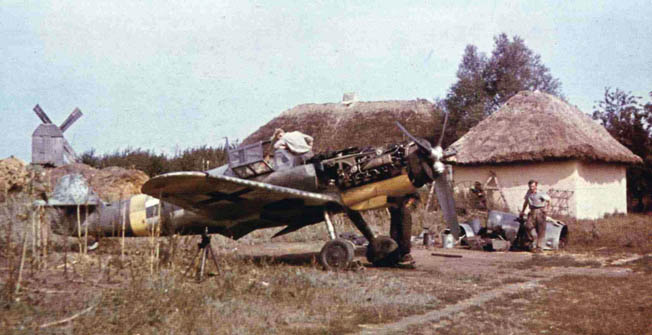
Hartmann repeatedly swerved out of the Russian’s line of fire, but the Yak pilot did not shoot. Bubi realized in shock that the man was trying to ram him. Radioing for his wingman, a Lieutenant Wester, to climb to a safe distance, Hartmann began throttling back so he could bank his plane in a tighter than usual turning radius in hopes of making the enemy overshoot him, but the Red pilot was good. He would not let Hartmann get behind him. He suddenly yanked his plane upward, turned, and charged the Me-109. Both pilots opened fire simultaneously and missed. Hartmann did a split-s, dove to treetop level, and stayed there for the moment.
As Hartmann had hoped, his opponent lost sight of him, and after circling in a futile pattern while Bubi expertly stayed directly under him, the Russian turned eastward for home. With his Me-109’s camouflage blending in with the ground under it, Hartmann slowly ascended from under his unsuspecting foe, closing to just 50 feet before opening fire. The Soviet pilot turned his Yak over, dropped from its cockpit, and yanked his ripcord, floating to earth deep in German territory. Hartmann hurried back to base, commandeered a Fiesler Storch reconnaissance plane, flew back, and personally picked up his latest victim, flying him back to JG-52’s airfield.
Stalin had decreed that any Soviet soldier who allowed himself to be captured was, by falling alive into German hands, committing high treason and would be dealt with accordingly when and if he was “liberated” by his own side. When Hartmann presented his prisoner to his Luftwaffe squadron, the young Russian seemed delighted to have survived but became furious when his captors informed him he was not to be shot. The Germans eventually realized he had no motive to escape and allowed him to wander their airfield unchaperoned for two days before shipping him to wing headquarters for interrogation.
As another spring broke over western Russia, Hartmann continued refining his dogfighting techniques. He found that by refraining from reacting to approaching enemy aircraft until the last second he could often pick up critical information on his opponent that he would miss by responding too quickly. He learned that second-rate and inexperienced airmen tended to open fire from too far away. Such pilots invariably went down in flames under his gunfire. If the approaching Russian held fire until the last moment, though, it was certain he was a battle tested, competent veteran.
Bubi developed a tactic specifically for these situations.
As his adversary reached optimal firing range, Hartmann would twist his Me-109 into the tightest turn possible and then simultaneously shove the stick forward while kicking the bottom rudder, sending his plane downward. When his opponent would attempt to copy the difficult maneuver, he would be distracted by the abrupt shift from positive to negative G forces.
At this point Hartmann would pull up into positive G force just as his confused foe began to experience weightlessness. Before the Russian could regain his orientation, Bubi would dive beneath him, pull up, and drill his underside. Hartmann called this stratagem his “personal twist regulations,” and tried to teach it to his comrades, but few had the skill to master it.
Hartmann received the oak leaves to his Knight’s Cross from the Führer himself at the Eagle’s Nest in Berchtesgaden on March 4, 1944. At this time the Red Army was massing its resources for the coming summer offensive, Operation Bagration. The baby-faced, 22-year-old pilot prodigy, his tunic heavy with decorations, returned to the front just in time for the most intense fighting of his career.
Throughout June and July, while the Allies landed far to the west in Normandy, the Red colossus tore apart the Wehrmacht in the east. Hartmann and his comrades of JG-52 seldom left their cockpits as they did their best to stem the unending stream of ground-attack Shturmoviks. By now it was second nature to the Blond Knight to swoop under the flying tanks and hit their sole weak spot. On July 1, he expended just 120 rounds in flaming three Il-2s in one dogfight of just a few minutes’ duration. This brought his tally to 250, and that night while he and his brother pilots were celebrating this lofty score, they received a radio message that he was being awarded the swords to his Knight’s Cross. His second meeting with Hitler was unforgettable.
It was August 3, 1944, when Hartmann reported to the Wolf’s Lair, the East Prussian headquarters where the Fuhrer had survived an attempt on his life two weeks earlier. The frail Hitler had lost all affability.
Hartmann listened in shocked silence as Hitler ranted hysterically against Germany’s professional officer corps, calling them all traitors and incompetents. Then he attempted to reassure Bubi that all was not lost, that new weapons systems would soon be jumping from the drawing boards and into combat, where they would send the Third Reich’s teeming enemies into headlong retreat. Hartmann wanted desperately to believe this, but he had been at the Eastern Front long enough to realize Hitler and his high command had mortally underestimated the Soviet Union three years earlier. Apart from its seemingly endless reservoir of men and material and the copious supplies it received from the Western Allies, it was simply too big to be completely occupied. Even if Germany somehow managed to reverse the front’s westward movement, there would always be plenty of room for Stalin’s legions to fall back and stage counterattacks. This realization made him forget his new decoration as he headed back to fly against impossible odds.
Despite the time he missed by going on leave, Hartmann scored 32 more kills from July 20 to August 22. Fifteen squadrons could have been made from the number of warplanes he had now destroyed, and his JG-52 comrades were also knocking down multitudes of planes. Yet for every one they torched, 10 more Soviet aircraft came droning from the east.
On August 23-24, Hartmann ignored terrible weather while downing 19 more planes. He was summoned to Wolf’s Lair to receive the diamonds to his Knight’s Cross. Arriving at the compound he amazed the Führer’s hulking SS bodyguards by refusing to surrender his sidearm before being ushered into Hitler’s presence, telling the SS he would sacrifice his lofty award rather than be insulted by such palpable distrust from the leader he had served. He was allowed to keep his pistol and became only the seventh day pilot to receive the diamonds.
At the luncheon following the ceremony, Hartmann sat to Hitler’s right, and the two men discussed the situation in the East, the Allies’ strategic bombing offensive, possible changes in flying strategy, and modifications to the training of new pilots. Both of them likely realized, however, that any such major changes should have been made at least two years earlier.
By this time Hitler’s main hope was that a political rift might break down the Allied coalition, slowing the inexorable advances from east and west and giving Germany’s brilliant scientists time to perfect the next generation of revolutionary weaponry. By this point Hitler had given up hopes of outright victory but thought perhaps his new wonder weapons might stabilize the fronts and enable him to negotiate an armistice.
Because of an incident he had personally witnessed, this scenario did not appear particularly far fetched to Hartmann. He and his squadron were finishing an interception mission against Soviet bombers over Budapest when a formation of American P-51 Mustangs suddenly dove into the melee. The astounded Germans watched as the Russian escort fighters turned and attacked the Americans, enabling all the fuel- and ammunition-bereft Luftwaffe fighters to escape.
Before Bubi could return to his unit, he received notification that Reich Marshal Hermann Göring had decreed that he was to be reassigned to a ground posting rather than risk being killed fighting for what Göring evidently realized was a lost cause. General of Fighters Adolf Galland talked Göring into retracting the transfer.
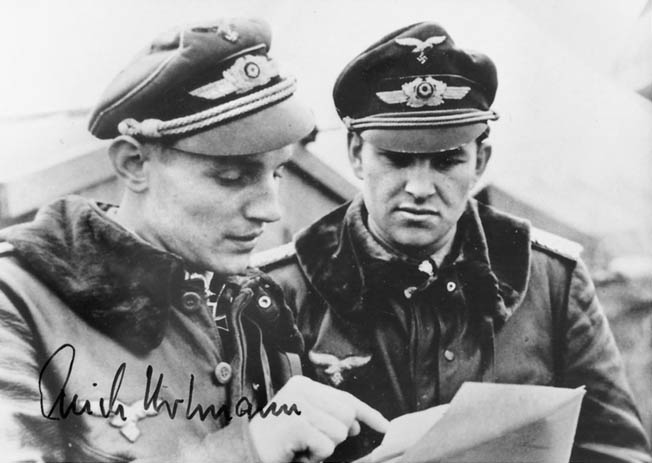
Hartmann then received another set of orders informing him he was to be reassigned to a group equipped with the new Me-262 jet interceptors. By then he was implacably attached to JG-52, and his desperate pleas to stay with his outfit led to these orders, too, being rescinded. He would spend 10 miserable years bitterly regretting this decision.
Realizing his state of physical exhaustion, military doctors managed to convince Hartmann to report to the Luftwaffe rest and recuperation center at Bad Wiessee. After he arrived there he got a great idea. Braving swarming Allied ground attack aircraft, he hopped a train to Stuttgart, gathered up Ursula, and returned with her to Bad Wiessee, where they were married on September 9, 1944. Eight days later he bade her farewell and returned to the front. Although neither of them knew it yet, Ursula was already pregnant with a son Erich Hartmann would never see.
As the war’s final winter descended on the Eastern Front, Bubi and his comrades in the air and on the ground were thrilled by news of the faraway Battle of the Bulge, but the news the Nazi propaganda organs kept promising, that the Western Allies had been pushed back into the English Channel, never came. As reality set in, the pilots of JG-52 stopped fighting with the hearty vigor this brief glimmer of hope had given them. It was replaced with resigned desperation.
In March 1945, Hartmann was ordered to report to Jagdverband 44, a newly organized jet unit. Because of his unfamiliarity with the Me-262 he was to fly as a wingman rather than remaining at the point. Flying behind another pilot was totally unacceptable to Bubi, who had no desire to leave his beloved Me-109 outfit. As soon as he reported to Galland’s new jet airfield at Lechfeld, he was delighted to receive new orders to return to JG-52, where he resumed cutting into the crumbling Reich’s deadly enemy. From the group’s base in Czechoslovakia, Colonel Hermann Graf had repeatedly requested Hartmann’s return to his miserably overworked outfit.
By this time the Blond Knight’s outfit was stationed outside the town of Deutsch-Brod. On his next patrol he got another taste of the tension between Germany’s enemies. He and three other pilots were all that were available to intercept a huge gaggle of Red Air Force bombers and escorts bound for Prague. Positioning their patched-up Me-109s above the ragged formation of Petlyakov Pe-2 and Lend-Lease American Bostons, the foursome prepared to make a plunge through the escorting Yak-9s and into the bombers. At this moment Bubi glimpsed another large flight of approaching fighters. They were American P-51 Mustangs, and they warily took up a position just above the Yak-9s.
With the Americans and Russians suspiciously eyeing each other, Hartmann realized they were too distracted to notice the tiny Luftwaffe formation lurking over them, and when the Germans attacked their foes would not notice in time to head them off. Still, the vast numerical imbalance would limit Hartmann and his men to just one pass.
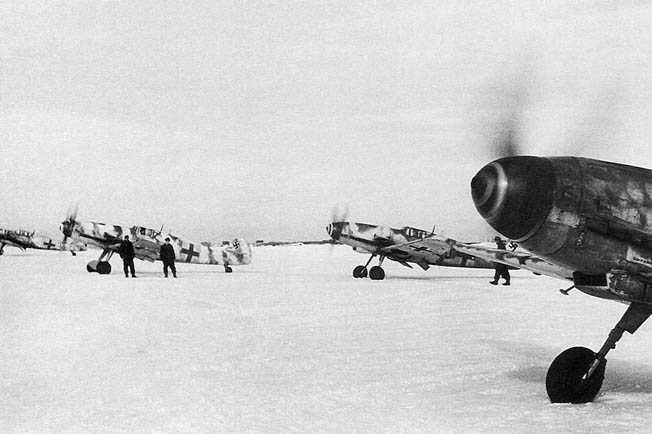
Plunging full speed through the three tiers of targets, Bubi flamed two Americans, passed through the Russian fighters without firing, and then knocked down a Boston. Continuing downward until leveling off just above the treetops, the Germans looked back to see the Yaks and Mustangs tearing into each other in a massive, swirling dogfight. The Me-109s had hurtled through the hostile formations at such speed that the Americans and Russians did not recognize them as German. With each side thinking the other had attacked, they turned on one another. For the moment the embryonic Cold War was quite hot.
In the closing months of the war in Europe, the Western and Eastern Fronts drew so close together that Hartmann encountered numerous Allied warplanes. The Blond Knight shot down seven Mustangs for his only non-Soviet kills. On May 8, 1945, he shot down the Yak-7 over Brunn for victory number 352, making him the highest scoring ace in military history.
With far fewer military aircraft being deployed by modern air forces, it is highly unlikely that any pilot will even threaten Erich Hartmann’s status as warfare’s supreme aerial ace. His JG-52 comrade Gerhard Barkhorn is second with 301 victories. Hartmann’s phenomenal vision, accuracy, and flying skill not only made him the most successful dogfighting military aviator in history, but also brought him through the horrors of the World War II without a scratch.
After landing following his last patrol, Hartmann learned of Germany’s surrender. He and the remaining pilots and ground personnel of JG-52 burned their Me-109s and surrendered. Along with the Third Reich, this greatest of all fighter groups had passed into history.